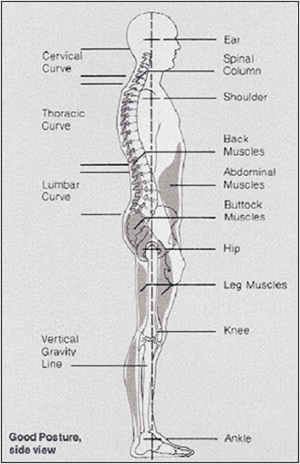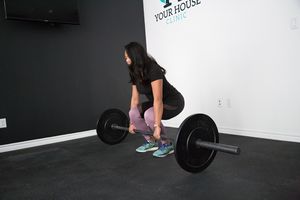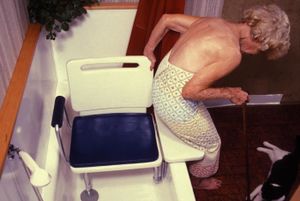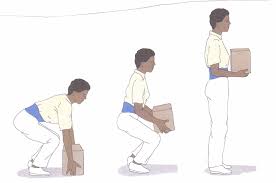Injury Prevention and Body Mechanics
Introduction[edit | edit source]
Body mechanics is a term used to describe the ways we move as we go about our daily lives. It includes how we hold our bodies when we sit, stand, lift, carry, bend, and sleep. Poor body mechanics are often the cause of back problems. When we don't move correctly and safely, the spine is subjected to abnormal stresses that over time can lead to degeneration of spinal structures like discs and joints, injury, and unnecessary wear and tear. That is why it is so important to learn the principles of proper body mechanics[1].
- Good body mechanics means using the body’s strength to the best mechanical advantage to do a task efficiently and without injury.
- A task does not have to be “heavy” or seem difficult to put us at risk for injury; many injuries occur because of the wear and tear of poor body mechanics on our bodies over time[2].
- Proper body mechanics are vitally important for keeping your spine healthy, it's easy to incorporate these principles into daily life.
Posture[edit | edit source]
Good body mechanics are based on good posture [read link].
Good posture means the spine is in a "neutral" position - not too rounded forward and not arched back too far.
“Neutral” Postures
- Avoid “awkward” postures that cause injuries,
- Try to keep the body close to a “neutral” or normal position while working and in daily tasks. ie a straight spine with the centre of gravity within the person's base of support.
- We move in and out of the “neutral” posture all the time! (ie: walking, reaching, etc.) The idea is to be as close to neutral as
- possible and do not use heavy forces (ie: pushing, pulling, lifting) when outside of our base of support[2].
Sitting
Whether sitting at a desk or at home watching television, good body mechanics are still important to keep in mind. For deskwork, consider investing in an ergonomically enhanced chair.
Good sitting:
- Place your buttocks at the back of the seat while maintaining a small space between the back of your knees and the seat of the chair.
- Place your feet flat on the floor with your knees bent at a 90° angle.
- Pull your shoulders back and lift your chest.
- Lift your chin until it is level and relax your jaw and mouth.
- If your chair has armrests, make sure they are positioned to support the weight of your arms. Not too high to make you hunch or too low to make you reach. Footrests can also be a helpful way to maintain good posture while sitting. Make sure the footrest is positioned so that your knees are bent comfortably and are level with your hips.
- Make sure you have enough support for your lower back. Look for a chair that has adjustable lumbar support. If that is not possible, increase back support by using a lumbar roll or even a rolled-up towel or cushion placed behind the lower back.[1]
Working with Wheelchair/seated clients Clients[edit | edit source]
In General:
- Plan first and set up equipment properly.
- Clear areas of obstacles.
- Transfer or lift a client over the shortest possible distances.
- Communicate with clients and other staff.
- Allow the client to assist as much as they are able to.
- Use general body mechanics principles.
- Always ask for assistance if you are not sure.
- NEVER lift or carry a client alone manually (must be lifted by at least two staff or by mechanical lift if alone)[2]
Injury Prevention Tips[edit | edit source]
• Design work/tasks that facilitate variety.
• During all loading tasks, avoid a fully flexed spine and rotate the trunk using the hips.
• During lifting, choose a posture to minimize the reaction torque on the low back (stoop, squat, etc), but keep the external load close to the body.
• Consider the transmissible vector: direct external forces through the low back when pulling on a door handle, vacuuming, etc.
• Use techniques that minimize the actual weight of the load being handled.
• Allow time for the disc nucleus to “equilibrate,” ligaments to regain stiffness, and stress on the annulus to equalize after prolonged flexion, and do not immediately perform strenuous exertions.
• Avoid lifting or spine bending shortly after rising from bed
• Pre-stress and stabilize the back even during light tasks.
• Avoid twisting and simultaneous generation of high twisting torques.
• Use momentum when lifting awkwardly placed light loads.
• Avoid prolonged sitting
• Consider the best rest break strategies based on your job demands.
• Practice joint-conserving kinematic movement patterns.
• Maintain a reasonable level of fitness.
Physiotherapy[edit | edit source]
Educate clients on proper body mechanics (table R, benefits of good posture)
- Muscle strains, especially those of the back, are a frequent reason for people coming to our clinic. Many people strain their backs because they carry and move objects incorrectly. It is vital to have the correct technique when lifting which we can demonstrate to you.
- Poor posture often leads to complaints of back, neck and shoulder pain, because it throws the muscles out of alignment. Poor posture may also alter gait which can lead to back and knee pain. By correcting posture, we can help clients avoid all these injuries.
- Assess posture and then prescribe effective exercises or suggest ways clients can improve posture at work/sport/ADL by assessing the ergonomics of their workstation.
- Mobilise stiff joints and stretch and massage tight muscles to improve your posture.
- Teach good lifting techniques and strengthen appropriate muscles.
- Ensure core muscles are strong and used correctly.
References[edit | edit source]
- ↑ 1.0 1.1 Colorado spine inst. Body Mechanics Available from:https://www.coloradospineinstitute.com/education/wellness/body-mechanics/ (last accessed 25.5.2020)
- ↑ 2.0 2.1 2.2 Ongwanada Body Mechanics and Injury Prevention Available from:https://www.ongwanada.com/wp-content/uploads/2019/10/Body-Mechanics-and-Injury-Prevention.pdf (last accessed 25.5.2020)











